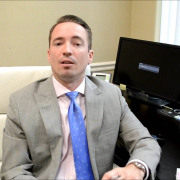Does Every Injury that Occurs at Work Create a Valid Workers Compensation Claim?
The simple answer to that question is: No, not in Utah. The Workers Compensation system controls injuries that occur at work. That means that an employee cannot bring a personal injury claim against his employer for an injury sustained at work. That is a disadvantage to Utah employees. The advantage of the system is that in order to prevail under the Workers Compensation system, an employee does not need to prove that the employer was negligent in order to recover. In a standard personal injury case, an injured victim could not recover anything unless he or she could prove that the employer was negligent in some way.
So, does that mean that if you get hurt at work you have a winning case no matter what? No. Your injury must be able to survive what is called “The Allen Test.” The Allen Test dictates which work related injuries are compensable under Utah Law, and which ones are not. The test comes from the landmark case, Allen v. Industrial Commission. That case was decided by the Supreme Court of Utah in 1986. The case was about an employee who injured his back while lifting crates of milk onto the shelves at a grocery store. This case is extremely important to Utah Workers Compensation law because the Justices wrote a lengthy opinion which detailed the entire history of how Utah Courts have determined which work-related injuries are compensable, and then they re-defined what the uniform law on that issue should be in all cases going forward. Since the case, the rule has been as follows:
In order for a work-related injury to be compensable the following two elements must be met:
- The injury must have happened by accident. That means that either the cause of the injury must be unexpected, or the result must be unexpected. The majority of work-related injuries satisfy this first prong of the test because most employees do not hurt themselves on purpose. Even internal failure injuries, like heart-attacks, are unintended.
- Element 2 is divided into two sub-parts. These sub-elements are really the crux of the issue. There must be a causal connection between the injury and the worker’s employment duties. The key question is, whether by a preponderance of the evidence, there is a sufficient causal connection between the injury and the working conditions. This question is answered by a 2 part analysis:
2.A – Legal Causation: When an employee has a preexisting medical condition which contributes to the injury, an unusual or extraordinary exertion is required for the legal causation prong to be met. The test is whether that exertion is unusual or extraordinary when compared with everyday activities that nonemployees perform. For example: taking out the trash, walking around the block, lifting a small child, carrying travel bags, etc. On the other hand, when there is no reason to believe that there is a preexisting condition, ordinary exertion is sufficient to satisfy legal cause. This part of the analysis can be tricky because sometimes it can be difficult to know whether or not there was any preexisting injury. When an internal failure injury coincidently occurs while at work, there is reason to suspect that there may have been a preexisting injury. When there is a preexisting injury, an extraordinary exertion must be shown. For that reason, legal causation can serve as a defense to many injuries that occur in the workplace. This standard of extraordinary exertion is the defensive offset intended to counter-balance the fact that people who live with preexisting injuries are more likely to be injured whether they are at work or not.
2.B. – Medical Causation: The second required prong of the causation element is met by showing that the exertion required by the job, led to the resulting injury. This is done through medical records or doctor’s opinions. This prong is easy to understand, if your doctor says that your injury was caused by whatever happened to you at work, this element is satisfied. Preexisting injuries are only relevant to medical causation to give the doctors a baseline by which they may judge the injury. If the work accident did not light up, or aggravate the preexisting condition at all, then there is no work injury.
In summary, proving that your injury claim is compensable through the Utah Workers Compensation system can be a difficult task. Make sure you schedule at least a free initial consultation with an experienced Utah Work Comp Injury Lawyer before you inadvertently create obstacles for your own recovery.



